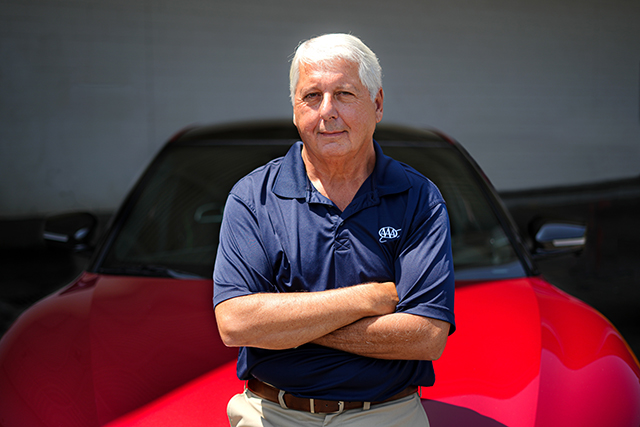Q. Both headlights, top portion, on my 2019 Hyundai Tucson are completely cloudy and discoloration with what appear to have minute cracks. Is there a service recall with this deformity with free replacement of the plastic headlight covers?
A. The only bulletin that I know of has to do with condensation. You may be able to buff out the cracks and remove the discoloration. This would be a part that would be normally covered by the five year, 60,000 mile warranty. Since you are outside of that period it may be worth asking the dealer if there is any good will assistance. If nothing else report the issue to https://www.nhtsa.gov/. Perhaps if enough people report this issue there will be a recall.
Q. I am the original owner of 2022 Volkswagen Tiguan SEL with 25,000 miles currently. Last week the low oil level appeared. I checked the oil, and it showed low. Upon research it seems 22-23 Tiguans are prone to oil consumption. Do you think this is something I need to be concerned about in the future, or trade in and get the GV70 I was looking for? Thank you for your column, great insights into auto issues.
A. Volkswagens tend to use some oil and in most cases VW/Audi consider one quart of oil use in 1200 miles normal. As a side note the plastic engine oil drain plug needs to get replaced on every oil change, if not it will leak. If you are considering trading your car, with the low miles and only three years old has good value. Since you purchased the car new the vehicle limited warranty covers the powertrain warranty for 5 years or 60,000 miles. So, if the oil consumption gets worse, you are covered. As a side note, VW has issued bulletins about oil consumption testing and oil quality. There is a class action suit, but nothing has been determined as far as I know. Would I trade it for a GV70, The GV 70 is a very nice vehicle, well designed and a good value for a luxury SUV. So yes, if it were me and the numbers work, I would trade it.
Q. My 2013 Chevrolet Equinox has 98,000 miles on it and needs a new water pump. The mechanic said I should also change the timing belt at a total cost of $2,600. I have been reading about this issue and understand both items should be done at same time due to the labor of getting at them. The cost estimates I am seeing ranges from $1,200-$1,500 for the complete job. Obviously $2,600 seems way out of line. In your opinion, is this a fair price?
A. I am a little confused because my information shows both the four- and six-cylinder engines having timing chains not belts. Typically, with regular service the timing chains should last the life on the engine. Based on what I am seeing and parts listed there is no timing belt. Unless the timing chain has stretched or it is rattling, I would replace the water pump and move on.
Q. I have been reading about and watching videos about Valvoline Restore and Protect oil. Most of the reviews are quite positive. Do you have an opinion on this oil?
A. In my own car I have been using Pennzoil Platinum synthetic once the car hit 15,000 miles. Recently I purchased six quarts of Valvoline Restore and Protect, which by the way is a little pricy-nearly $11.00 per quart. The reasoning is, the engine in my car has a history of sticky piston rings. Based on what I have seen in chemical analysis this oil may help prevent a future problem.
Q. I have a 2020 Subaru Forester and when it was in a local shop for an oil change the technician showed me some cracking in the front suspension bushing. He said it was not serious, but it is something I should take care of in the future, maybe by year end. Any thoughts on this?
A. Some cracking in rubber bushing is normal and to be expected with age. If you take a screwdriver and stress the crack and it goes completely through the bushing, the bushings need replacement. In fact, Subaru states cracks with a width greater than 13mm (1/2 inch) will have an impact on the vehicle ride quality and will require replacement. Cracks with a width of 13mm (1/2 inch) or less will not cause any functional concerns and will not require replacement.
Q. I had an issue with my car running rough. I went to the dealer to ask about service, and they suggested based on experience, that the car has excessive carbon build up. They recommended cleaning using walnut shells. What do you know about this?
A. Years back the engine combustion chamber and specifically the intake valves would build up with carbon deposits. The issue was mostly solved with gasoline with a higher percentage of cleaning additive. Today we are seeing a similar issue with direct injection design engines. Direct injection engines are prone to carbon buildup because fuel is injected directly into the cylinder, rather than at the intake valves. This lack of fuel cleaning additive at the valves and ports leads to more combustion deposits over time. The walnut shell blaster is used once the intake manifold is removed to blast off any deposits. I first heard about walnut shell blasting to clean carbon buildup in aircraft engines. The walnut shell abrasive can be easily targeted to the valves and without causing damage to any other parts.
Do you have car questions? Email AAA’s Car Doctor for a personal reply: jpaul@aaanortheast.com.
4 Thoughts on “Q&A With AAA Northeast’s Car Doctor: May 2025”
Leave A Comment
Comments are subject to moderation and may or may not be published at the editor’s discretion. Only comments that are relevant to the article and add value to the Your AAA community will be considered. Comments may be edited for clarity and length.






i hope you can help me. I bought a 2022 kia soul lx from enterprise it is a good used car. directly to the right of driver there is a cubby box where you can put stuff into it. i was putting stuff into it then one day i was looking for something in it and could not find it. i took everything out and that is where i saw a little hole that used to have a plastic piece over it. i have tried kia parts and going online to find that piece but no luck. maybe you can help. i have it covered now with lots of black adhesive tape after i had to buy a grabber to get most of the stuff out of it.
I’m the owner of a Dodge Durango,2018, 3.8 litre V-6 and have been a Chrysler product owner my whole life. Everything fine and well maintained until a slight rough idle at approximately 108k miles. At 110k miles the check engine light came on and within 5 minutes at highway speed , the light started flashing and the engine began a heavy misfire.Codes indicated misfire on cylinder 3, my mechanic replaced coil pack, switched injectors but still no good. Diagnosis was worn camshaft.Ordered the camshaft from Dodge on March 14 and still no part. In the meantime a friend of mine who has a Dr. Motorworks shop in Virginia, tells me that this is a fairly common problem and that he’s replaced a number of these cams at around 85,000 miles. He believes the problem stems from inferior steel from China that Chrysler uses in its products. This information prompted me to try Chrysler customer service and explain the situation and that I just had passed my 100k mile extended warranty and was there any possibility that this issue might be covered by Chrysler. Total dead end there and no help or satisfaction. Have you had any experience or know of this cam issue ? If so , do you have any recommendations for me ? Thanks for your time and I totally enjoy your weekly column in Newsday.
This is great information. I hope that there will be more forthcoming.
Thank you.
I have a 2017 Toyota Lexus with a V-6 gas engines. I want to purchase a 2023-2024 Lexus but am not sure the new Turbocharged engines are as reliable as the gas V-6 engine. Can you explain the difference in engines? Thank you